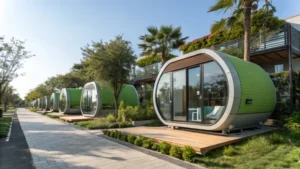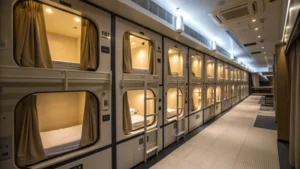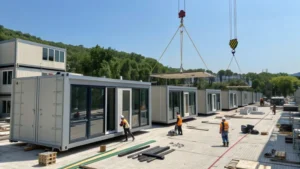%[Comparison of a space capsule and a spacecraft in outer space](https://cozehouse.com/wp-content/uploads/2024/12/space-capsule-vs-spacecraft.webp "Space Capsule vs Spacecraft")
Remember that sense of wonder you had as a kid staring up at the stars, dreaming of space adventures?
**A capsule is like a trusty, snug car for space, focusing on getting people and cargo safely to and from space, often with a compact, conical design. A spacecraft, however, is the umbrella term for all space vehicles, from shuttles to rovers, each tailored for unique missions.**
While the straightforward definitions give us a peek into their main purposes, delving into the details of design, functionality, and mission objectives shows just how distinct capsules and spacecraft really are in the world of space exploration. By exploring these differences, we get to appreciate how each plays a crucial role in our cosmic adventures and technological leaps.
Capsules are always conical in shape.False
Capsules are often conical for reentry efficiency but not always.
Spacecraft includes vehicles like rovers and shuttles.True
Spacecraft is a broad term covering various mission-specific vehicles.
## What Are the Key Design Differences Between Capsules and Spacecraft?
Ever wondered how the designs of capsules and spacecraft differ and why these differences are crucial for their missions? Let me share what I've learned.
**Capsules are compact, often conical vehicles designed for short-term missions and re-entry, focusing on safety and simplicity. Spacecraft is a broader category, including capsules, shuttles, and more, catering to diverse missions like exploration and station docking.**
%[A space capsule and spacecraft in outer space with Earth below](https://cozehouse.com/wp-content/uploads/2024/12/space-capsule-and-spacecraft-in-outer-space.webp "Space Capsule and Spacecraft")
### Shape and Aerodynamics
You know, when I first started diving into the world of space design, I was fascinated by how much thought goes into the shapes of these vehicles. Capsules often have this conical or cylindrical look. Imagine it like those fun slides at water parks that swirl you down safely—it's all about minimizing heat and resistance as they re-enter Earth's atmosphere. In contrast, spacecraft designs are as varied as a box of chocolates! From winged shuttles that glide back to Earth like majestic birds to spherical probes venturing into the unknown, each design serves a unique purpose.
| **Design Aspect** | **Capsules** | **Spacecraft** |
|-------------------|--------------|---------------|
| Shape | Conical/Cylindrical | Varies (e.g., Shuttle Wings) |
| Aerodynamics | Re-entry Focus | Mission-Specific |
### Purpose and Functionality
I've always been a fan of stories where form meets function, and in space exploration, this is especially true. Capsules are like those reliable friends who always get you home safely—they're mostly about getting humans or cargo between Earth and space efficiently. The [Orion Capsule](https://www.nasa.gov/humans-in-space/orion-spacecraft/)[^watkddbcas-1] and SpaceX's Crew Dragon come to mind as perfect examples.
Spacecraft, on the other hand, are the adventurers of the cosmos. Whether it's interplanetary exploration or docking at a space station, they are built to handle the grandeur of long-term missions. Vehicles like the Mars Rover aren't just about getting from point A to B; they're about the journey and discovery itself.
### Size and Capacity
Here's a fun fact I found intriguing: capsules might be small, but they pack a punch! They can fit up to seven crew members in their compact designs. It's like squeezing into a car with friends for a road trip—efficient and cozy. Yet, for larger cargo, separate ships often tag along.
Spacecraft remind me of those huge family vans that can carry everything from your luggage to your dog. They're generally bigger and can hold more crew and cargo, making them perfect for extensive missions.
### Reusability and Lifespan
The push for reusability in modern capsules is something I find absolutely brilliant—like recycling in action. Take the Crew Dragon; it's made to fly multiple times without breaking the bank. Its missions usually last from days to weeks.
Spacecraft like the [Space Shuttle](https://www.nasa.gov/johnson/exhibits/space-shuttle-the-reusable-system/)[^watkddbcas-2] share this reuse feature but come with a bit more complexity. Their missions can last years, especially when exploring places like Mars.
### Missions and Usage
Capsules seem tailor-made for high-stakes journeys—think of them as the safety nets of space tourism or essential resupply missions to the ISS. Their designs ensure a safe return from space.
Spacecraft cover an even broader spectrum. They're like Swiss Army knives for space—equipped for everything from planetary exploration to interplanetary travel. Some are designed for extended missions, highlighting their versatility.
Understanding these design differences really opens up how each vehicle is perfectly crafted for its role in space exploration.
Capsules are designed for short-term missions.True
Capsules focus on transporting humans or cargo for short to medium-term missions.
Spacecraft are only used for interplanetary travel.False
Spacecraft serve various purposes, including space station activities and exploration.
[^watkddbcas-1]: Discover Orion Capsule's design features that make it ideal for crewed lunar missions.
[^watkddbcas-2]: Explore how the Space Shuttle's design allows for multiple missions and cost efficiency.
## How do the missions of capsules and other spacecraft differ?
Imagine blasting off into space with a mission tailored just for your journey. That's the magic of different spacecraft.
**Capsules are designed for safe, reusable transport of humans or cargo between Earth and space. Other spacecraft, like rovers and shuttles, handle tasks such as planetary exploration and servicing space stations.**
%[A cosmic scene with three types of spacecraft in outer space.](https://cozehouse.com/wp-content/uploads/2024/12/cosmic-spacecraft-scene.webp "Cosmic Spacecraft Scene")
### Design and Purpose
When I think about capsules, it's like picturing a cozy, conical home rocketing through space—kind of like a high-tech tent for astronauts. These capsules, such as SpaceX's Crew Dragon or NASA's Orion Capsule, are built to safely ferry astronauts and cargo to places like the International Space Station. Their mission is usually short to medium-term, focusing on getting there and back efficiently.
Now, imagine having a range of different space vehicles at your disposal, each crafted for specific adventures. Other spacecraft, such as rovers or shuttles, are designed for more diverse missions. Take the Mars Rover, for example—it’s designed to explore the red planet's surface for years, uncovering secrets about its terrain and atmosphere.
### Size and Capacity
| Feature | Capsules | Other Spacecraft |
|----------------|-----------------------------|-----------------------------|
| Crew Capacity | Typically 1-7 | Varies (5-7 in shuttles) |
| Cargo Capacity | Limited, often separate | Larger payloads possible |
While capsules are all about compact efficiency—like a snug cabin prioritizing safety and energy use—other spacecraft can offer roomier accommodations. The [space shuttles](https://en.wikipedia.org/wiki/Space_Shuttle)[^hdtmocaosd-1], for instance, can carry more crew and cargo, making them ideal for more extensive missions.
### Mission Duration and Lifespan
Capsules feel like short-term rentals; they’re meant for those quick hops lasting from a few days to a few weeks. Perfect for darting up to the space station and back. But some, like SpaceX's Crew Dragon, are reusable, reducing costs over time.
On the other hand, think of other spacecraft as long-term leases. Vehicles like the Mars Rovers are in it for the long haul, operating for years on end as they explore distant landscapes.
### Safety and Reusability
Safety is key when designing capsules. It's like having a reliable parachute when skydiving—these capsules often come equipped with abort systems to keep crews safe during launch mishaps using parachutes for gentle landings.
Spacecraft such as the Space Shuttle were also crafted with safety in mind but with added complexity. They have wings for landing and can perform a variety of tasks like docking at space stations or deploying satellites.
To explore more about how these vehicles fit into different mission roles, check out [spacecraft mission types](https://science.nasa.gov/learn/basics-of-space-flight/chapter9-1/)[^hdtmocaosd-2].
Capsules have a conical shape for re-entry efficiency.True
The conical design of capsules aids in safe and efficient re-entry.
Mars Rovers are designed for short-term space missions.False
Mars Rovers are built for long-term exploration, lasting years.
[^hdtmocaosd-1]: Explore the space shuttle's capacity for larger payloads compared to capsules.
[^hdtmocaosd-2]: Gain insights into various spacecraft mission types and their specific roles.
## How is Reusability Changing Space Travel with Capsules and Spacecraft?
Have you ever wondered how reusability is transforming space travel, especially when it comes to capsules and spacecraft?
**Reusability in space capsules like SpaceX's Crew Dragon and spacecraft such as NASA's Space Shuttle not only cuts costs but also reduces environmental impact. This allows for more frequent missions and paves the way for technological advancements in aerospace.**
%[A futuristic space capsule alongside NASA's Space Shuttle in outer space with a starry background.](https://cozehouse.com/wp-content/uploads/2024/12/futuristic-space-capsule-and-space-shuttle.webp "Futuristic Space Capsule and Space Shuttle")
When I first heard about the concept of reusability in space travel, I was intrigued. Imagine launching into space and then reusing the same capsule or spacecraft multiple times. This isn’t just a sci-fi dream—it's happening now! Let's dive into why this matters.
### Cost-Effectiveness Through Reusability
Capsules like SpaceX's Crew Dragon demonstrate significant cost savings through [reusability](https://nstxl.org/reducing-the-cost-of-space-travel-with-reusable-launch-vehicles/)[^hircstwcas-1]. Each launch benefits from reduced material expenses and shorter refurbishment times. It's like having a favorite pair of shoes that you can just clean up and wear again, instead of buying new ones each time. This is a stark contrast to older spacecraft, which are like those high-maintenance sneakers that require constant care.
| Spacecraft Type | Reusability Benefits |
|-----------------|----------------------------|
| Capsules | Lower costs, quick turnaround|
| Spacecraft | High maintenance costs |
### Environmental Impact
The environmental benefits are something I find particularly exciting. The reduced need for new materials in reusable capsules contributes to [sustainability](https://roundupreads.jsc.nasa.gov/roundup/1673)[^hircstwcas-2]. Frequent use of existing components minimizes waste and lowers the carbon footprint of space missions. It’s akin to recycling on a grand scale, reducing our carbon footprint significantly. In comparison, traditional single-use spacecraft are like disposable coffee cups—useful but wasteful.
### Innovation and Technology Advancements
Reusability drives innovation by pushing boundaries in design and technology. For instance, the development of advanced heat shields for capsules ensures they can withstand re-entry multiple times. It's like upgrading your phone to the latest model—it keeps getting better and more efficient.
| Innovation Area | Capsules | Spacecraft |
|-----------------|--------------------|-------------------|
| Heat Shields | Durable, lightweight | Complex, multi-layer |
| Propulsion | Efficient re-entry | Long-duration missions|
### Frequency of Missions
Thanks to reusability, we can now have more frequent missions. Just think about how [SpaceX](https://en.wikipedia.org/wiki/SpaceX_reusable_launch_system_development_program)[^hircstwcas-3] has revolutionized the frequency of trips to space! This increases opportunities for research and development in space travel. It reminds me of the shift from dial-up internet to broadband; suddenly, everything was faster and more accessible.
Exploring the multifaceted impact of reusability on space capsules and spacecraft reveals a transformative trend towards more sustainable, cost-effective, and innovative space exploration methodologies. This not only affects current missions but also shapes future capabilities in reaching new frontiers. Further understanding how each system benefits from reusability can enhance our approach to space travel and exploration.
| Mission Frequency | Capsules | Spacecraft |
|-------------------|----------------|---------------|
| Low Earth Orbit | Frequent | Less frequent |
| Interplanetary | Developing | Established |
Reusable capsules reduce mission costs significantly.True
Capsules like SpaceX's Crew Dragon save on material and refurbishment costs.
Traditional spacecraft have lower maintenance costs than capsules.False
Traditional spacecraft require extensive post-mission maintenance, unlike reusable capsules.
[^hircstwcas-1]: Learn about the cost-saving benefits of reusing components in space capsules like Crew Dragon.
[^hircstwcas-2]: Discover how reusing space capsule components contributes to sustainability and reduces environmental impact.
[^hircstwcas-3]: Explore how reusability allows SpaceX to conduct more frequent missions, advancing space exploration.
## Why do space capsules have greater safety concerns than other spacecraft?
You know that heart-pounding thrill of watching a space capsule re-enter Earth’s atmosphere? Well, behind that spectacle lies a meticulous dance of engineering and safety protocols.
**Capsules face heightened safety concerns due to their compact design and critical re-entry phase. Unlike larger spacecraft, capsules are tailor-made for specific missions, necessitating advanced safety measures during launch and atmospheric re-entry to protect crew and cargo.**
%[A space capsule re-entering Earth's atmosphere surrounded by flames](https://placehold.co/800x450.webp?text=Upload+Failed "Space Capsule Re-entry")
### Design and Re-entry Challenges
Whenever I think about the [design of space capsules](https://stemnext.org/wp-content/uploads/2020/11/Splashdown-Activity-Guide-2020-10-30.pdf)[^wdschgsctos-1], I'm reminded of how they're like the Swiss Army knives of space travel—compact yet packed with everything needed for survival. Their conical or cylindrical shapes aren't just for show; they’re crucial for managing the intense heat of re-entry. Imagine a tiny cocoon, hurtling back to Earth, wrapped in a heat shield to withstand searing temperatures. It's a marvel of engineering!
| Feature | Capsules | Larger Spacecraft |
|--------------------|---------------------|---------------------|
| Shape | Conical/Cylindrical | Varies (Wings, Wheels) |
| Landing Mechanism | Parachutes | Wheels/Wings |
| Re-entry Protection| Heat Shields | Varied Systems |
### Mission-Specific Safety Features
Space capsules are like the adrenaline junkies of spacecraft, often designed for high-stakes missions where every second counts. Whether ferrying astronauts to the ISS or delivering essential cargo, these missions demand specialized safety systems. Take abort systems, for instance. They’re like the ejection seats in fighter jets—there to save the day if things go sideways during launch.
The specificity of these missions emphasizes the need for reliable [safety mechanisms](https://ntrs.nasa.gov/api/citations/20070021628/downloads/20070021628.pdf)[^wdschgsctos-2], ensuring crew protection.
### Comparison with Other Spacecraft
While capsules are laser-focused on safely delivering their human or cargo payloads back to Earth, other spacecraft like [Mars rovers](https://science.nasa.gov/planetary-science/programs/mars-exploration/rover-basics/)[^wdschgsctos-3] play the long game. They're built for endurance, not re-entry drama. On the flip side, the Space Shuttle was like a flying fortress, with its own set of complex safety dynamics due to its reusable nature and wide-ranging mission capabilities.
It's fascinating to see how these differences play out in real-world applications. Whether it's a quick jaunt to low Earth orbit or an extended exploration mission, each type of spacecraft embodies its own unique set of challenges and solutions.
| Aspect | Capsules | Larger Spacecraft |
|------------------------|-------------------|-----------------------|
| Primary Safety Concern | Re-entry | Landing Mechanisms |
| Mission Duration | Short-term | Variable (Long-term) |
| System Complexity | Simple | Complex |
The art of space travel continues to push boundaries and challenge our perceptions of what's possible.
Capsules rely on heat shields for re-entry protection.True
Capsules use heat shields to withstand extreme temperatures during re-entry.
Space capsules have more complex systems than larger spacecraft.False
Capsules have simpler systems compared to the complexity of larger spacecraft.
[^wdschgsctos-1]: Explore the design intricacies that make capsule safety paramount, focusing on aerodynamic shapes and materials.
[^wdschgsctos-2]: Learn about specialized safety systems in capsules, like abort mechanisms during launch.
[^wdschgsctos-3]: Understand how Mars rovers differ in design priorities compared to space capsules.
## Conclusion
Capsules are compact, conical vehicles designed for safe transport to and from space, while spacecraft encompass a broader range of vehicles for diverse missions in space exploration.










